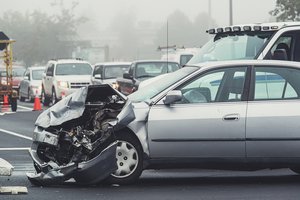
When you are involved in an automobile collision, one question is who is going to pay for the damage to your car.
Who caused the collision?
You must first determine who caused the collision. If you caused the collision, you would need to contact your own insurance company and make a claim under your collision coverage portion of your insurance policy. Hopefully you have that type of coverage. Check your insurance policy now to see that you have that coverage.
If you were not at fault for the collision and another person caused the collision, you need to find out if that person has liability insurance. If the at-fault person has liability insurance, then you can contact their insurance company and make a claim for your property damage. Hopefully, the insurance company will accept responsibility for the collision and be willing to pay for the damages to your vehicle.
As an aside, given some automobile parts shortages due to COVID, many repair shops have a back-log and it can take time to get your vehicle repaired. In the meantime, you will need a rental car. Again, the at-fault party’s insurance company should pay for your rental car. If they will not, then if you have rental insurance coverage under your policy, you can make a claim with your own insurance company for the rental car.
Some insurance companies are slow to respond or will not make a decision as to whether they accept responsibility for the collision. The at-fault driver's insurance policy might say it has not been able to talk to their insured (the at-fault party) or they are still investigating the claim. In that instance, you might want to make a claim with your own insurance company for the repair of your vehicle. You will have to pay your deductible and then your insurance company will pay for the repairs. However, if another party is at-fault and has insurance, your insurance company has a right of subrogation against the at-fault driver’s insurance company. That means it has a right to seek recovery for the amounts it paid on your behalf from the at-fault driver’s insurance company. This would include your deductible. If your insurance company makes a claim against the at-fault driver’s insurance company and recovers what it paid, your insurance company should refund you the deductible that you paid.
Sometimes your own insurance company might discourage you from making a claim for property damage under your own insurance policy when you did not cause the collision. But the point is that you need a vehicle to drive. And if the other insurance company is dragging its feet and not making a decision, you need to get your vehicle repaired and the quickest way is to make a claim under your own insurance policy.
Now what do you do if the at-fault driver did not have any liability insurance? Again, you have to look to your own insurance company and see if you had uninsured motorist coverage. Uninsured motorist coverage is the type of insurance where the at-fault driver did not have any liability insurance. If you have uninsured motorist coverage, you can make a claim for uninsured motorist benefits for the property damage to your vehicle. In Texas, insurance companies are required to provide uninsured/underinsured motorists coverage unless you reject the coverage in writing.
What if the cost of repairs are more than the at-fault driver’s insurance policy limits?
Let’s take this example. The at-fault driver has minimum limits insurance coverage. In Texas, that is $25,000 for property damage. Now let’s assume you are driving a brand-new car and the damage to your vehicle is $40,000.00. What now? Who is going to pay for all the damage to your vehicle? Assuming the at-fault driver has no excess policy which is most likely given most insurance companies will not write an excess policy if the underlying insurance policy is minimum limits, then you have to look to your own insurance company for the difference between the cost of repairs and the at-fault driver’s policy limits. In our example above, it would mean the at-fault driver’s insurance company would pay its $25,000 in insurance coverage for the repairs and you would need to make a claim against your underinsured motorist coverage for the remaining $15,000 in repairs. That is why it is so important to ensure that you carry uninsured/underinsured motorist coverage and in sufficient amounts. It is even more important if you are seriously injured in a collision due to the fault of another person and that person does not have adequate amounts of insurance to pay for your damages. And don’t make the mistake of just carrying minimum limits on your uninsured/underinsured motorist coverage. Minimum limits coverage is not going to protect you if you are involved in a serious collision.
If you were involved in a collision, you should consult with an experienced personal injury attorney. At the Kisselburgh Law Firm, we have been representing those injured due to the fault of others for over 30 years.
